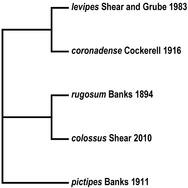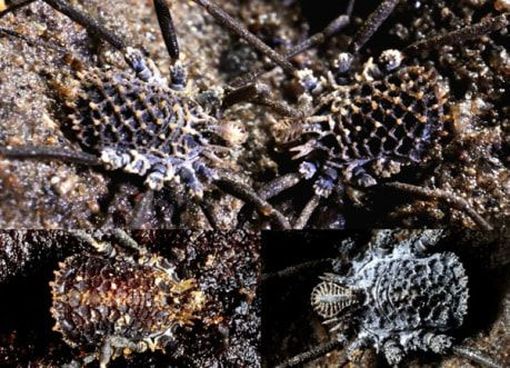Ortholasma Banks, 1894

Phylogenetic concept derived from morphology and interpretations of Shear and Gruber (2010) and Shear (2010).
Ortholasma is characterized by a hood process lacking dorsal spines on the median ridge and by males having a plateau-like bristle field associated with a glandular area dorso-distal on the basal cheliceral segment (Shear and Gruber 1983). Dorsal ornamentation consists of large cells without subdivision, forming tubercles (Shear 2010). The penial glans is very short and set with small spines, in contrast, the stylus is very long, irregular tubular and apically blunt, often forming a short hook. Species are found along the western coast of North America from Northern Mexico to Southern Canada.
Taxonomy and Discussion of Phylogenetic Relationships
The species Ortholasma colossus and O. rugosum are closely related according to body size and other external features. Another likely species pair is O. coronadense and O. levipes, showing relatively narrow hoods and the hairs in the area of the ventral glandular field of the pedipalp patella in males are sparser than in other species.
Ecology and Life History
Several Ortholasma species appear more drought resistant than other Nemastomatidae. O. coronadense occurs in dry chaparral and oak forests along the coast, yet only in favorable humid microhabitats (Shear and Gruber 1983). O. pictipes is clearly associated with the coastal redwood forests and O. colossus with forests in the Sierra Nevada as both require higher humidity.
References
Shear, W. A. 2010. New species and records of ortholasmatine harvestmen from México, Honduras, and the western United States (Opiliones, Nemastomatidae, Ortholasmatinae). ZooKeys 52:9-45.
Shear, W. A. and J. Gruber. 1983. The opilionid subfamily Ortholasmatinae (Opiliones, Troguloidea, Nemastomatidae). American Museum Novitates 2757:1-65.
Credits
Page created by Axel L. Schönhofer. Angela DiDomenico helped improve the English.
Ortholasma is characterized by a hood process lacking dorsal spines on the median ridge and by males having a plateau-like bristle field associated with a glandular area dorso-distal on the basal cheliceral segment (Shear and Gruber 1983). Dorsal ornamentation consists of large cells without subdivision, forming tubercles (Shear 2010). The penial glans is very short and set with small spines, in contrast, the stylus is very long, irregular tubular and apically blunt, often forming a short hook. Species are found along the western coast of North America from Northern Mexico to Southern Canada.
Taxonomy and Discussion of Phylogenetic Relationships
The species Ortholasma colossus and O. rugosum are closely related according to body size and other external features. Another likely species pair is O. coronadense and O. levipes, showing relatively narrow hoods and the hairs in the area of the ventral glandular field of the pedipalp patella in males are sparser than in other species.
Ecology and Life History
Several Ortholasma species appear more drought resistant than other Nemastomatidae. O. coronadense occurs in dry chaparral and oak forests along the coast, yet only in favorable humid microhabitats (Shear and Gruber 1983). O. pictipes is clearly associated with the coastal redwood forests and O. colossus with forests in the Sierra Nevada as both require higher humidity.
References
Shear, W. A. 2010. New species and records of ortholasmatine harvestmen from México, Honduras, and the western United States (Opiliones, Nemastomatidae, Ortholasmatinae). ZooKeys 52:9-45.
Shear, W. A. and J. Gruber. 1983. The opilionid subfamily Ortholasmatinae (Opiliones, Troguloidea, Nemastomatidae). American Museum Novitates 2757:1-65.
Credits
Page created by Axel L. Schönhofer. Angela DiDomenico helped improve the English.

